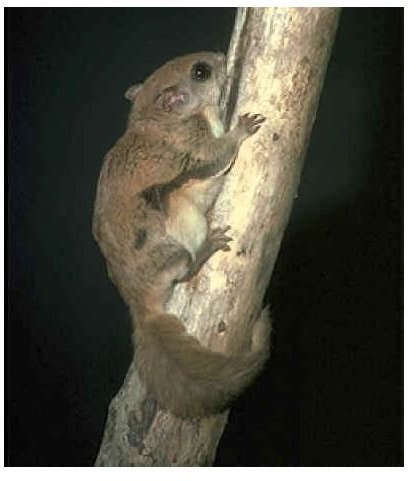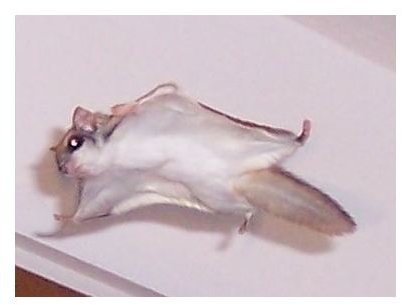Fun and Interesting Facts about Flying Squirrels
Do They Really Fly?

Although they are called flying squirrels, they do not actually fly (they glide). There are about 50 different species that can be found around the world. In North America, there are two species: Southern (Glaucomys volans) and Northern (Glaucomys sabrinus). Below, you will find many interesting flying squirrel facts.
Description
The Southern and Northern flying squirrels are similar in looks. The Northern adult is up to 12 inches long (including its tail) and weighs about 4 to 6 1/2 ounces. The Southern adult is shorter and weighs about a third of the Northern species.
Males and females look alike. Because they are nocturnal animals (active at night), they have large, bulging eyes that help them to see in the dark. They also have sensitive whiskers called “feelers” that help them move around in the dark.
Flying squirrels have a furry membrane (called patagia), that extends along each side of their body between the front and back legs. When the squirrel glides, it opens its legs and uses the stretched membrane like a parachute. The tail is broad and flat and is needed to help with gliding as well.
Gliding

The glide starts from a high branch in a tree. Once they land, they climb back up a tree before they continue their flight. Flying squirrels use their “parachute”, legs, and tail to steer. They are able to make 180 degree turns. The tail is also used as a stabilizer and as a brake when landing. Depending on the species, wind, and takeoff height, they can glide about 80-150 feet. The longest recorded glide is nearly 300 feet.
Habitat
Flying squirrels need a large wooded area where the trees are spaced enough to allow them to glide. The Southern species normally occupies hardwood forests of maple, hickory, beech, and oak while the Northern species prefers coniferous forests (trees bearing cones and evergreen leaves). They nest in holes in trees. Some may den in barns or houses.
Behavior
Flying squirrels are active throughout the year and are highly sociable. They often feed and den together, especially when the weather is harsh.
Diet
Flying squirrels are omnivorous, meaning they eat both animals and plants. Their favorite foods are nuts, including acorns, pecans, and hickory nuts. One really interesting fact about these squirrels is they can store up to 15,000 nuts in one season. They also eat bark, tree sap, seeds, flowers, berries, fruits, mushrooms, lichens, slugs, snails, young mice, insects, bird eggs, baby birds, and (especially during the winter time) dead and rotting bodies of animals.
Reproduction
The Northern females have one litter per year. The Southern females may have two litters per year (early spring and summer). The gestation period is approximately 40 days. The average litter size is 2-4 but can range from 1-7. The babies are born with no fur, fused toes, and closed eyes and ears. The fur starts to grow in by 7 days, the toes are separated by 6 days, the eyes open in about 24-30 days, and the ears open in about 2-6 days.
Predators
Flying squirrels have numerous predators, including raccoons, foxes, coyotes, owls, snakes, birds, and domestic cats and dogs.
More Information
More interesting facts about flying squirrels include:
• DNA is the only way to tell the difference between the Southern and Northern species. The two species are not known to interbreed.
• When feeding on tree nuts, flying squirrels will make one opening in the shell to draw out the meat whereas other squirrels break the nuts into many pieces to get the meat.
• Their lifespan is about 6 years in the wild and 10-15 years in captivity.
• The largest flying squirrel, found in South Asia, is up to 4 feet in length.
Lesson Plan
Nuts for Squirrels: Squirrel Lesson Plans for Preschool
Sources Used
https://www.encyclopedia.com/topic/flying_squirrel.aspx
https://www.sialis.org/flyingsquirrel.htm
https://www.ct.gov/dep/lib/dep/wildlife/pdf_files/outreach/fact_sheets/flysqrl.pdf
Photo Credit
Southern flying squirrel picture courtesy of the U.S. Fish & Wildlife Service (in the public domain).
Southern flying squirrel in flight picture courtesy of https://commons.wikimedia.org/wiki/File:Jill_Flying_1.jpg